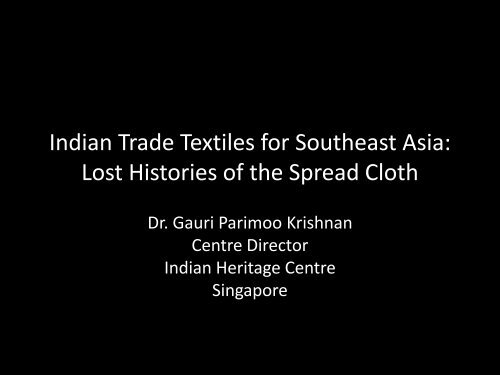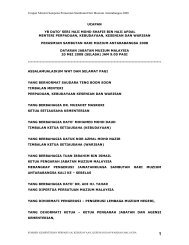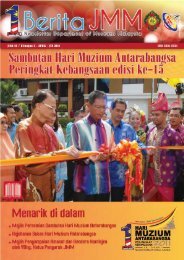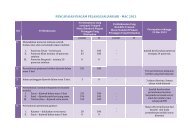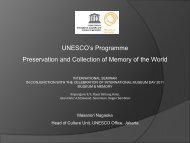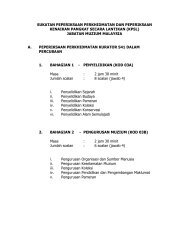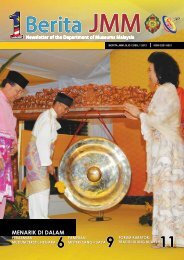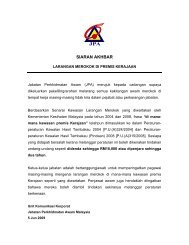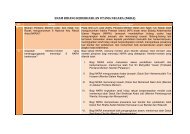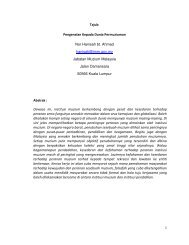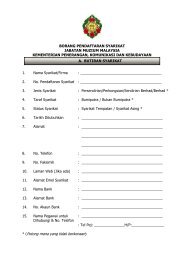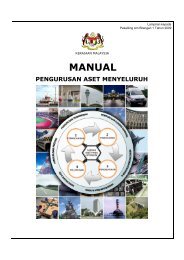Indian Trade Textiles for Southeast Asia
Indian Trade Textiles for Southeast Asia
Indian Trade Textiles for Southeast Asia
You also want an ePaper? Increase the reach of your titles
YUMPU automatically turns print PDFs into web optimized ePapers that Google loves.
<strong>Indian</strong> <strong>Trade</strong> <strong>Textiles</strong> <strong>for</strong> <strong>Southeast</strong> <strong>Asia</strong>:Lost Histories of the Spread ClothDr. Gauri Parimoo KrishnanCentre Director<strong>Indian</strong> Heritage CentreSingapore
Significance of <strong>Indian</strong> <strong>Trade</strong> Clothes(ITC)• Highlight the importance of <strong>Indian</strong> piece goods in Global trade• Role of ITC in non European intra‐<strong>Asia</strong>n trade• Even in the era of expansion of European powers in <strong>Asia</strong>,growth of global trade is not due to their expansion but dueto <strong>Asia</strong>n regional traders in SA, SEA and China.• <strong>Asia</strong>n trade in piece goods existed even beyond the VOC andEIC defined needs of spice <strong>for</strong> cloth trade• Based on collection data, standard view of sharp discontinuityin <strong>Asia</strong>n <strong>Trade</strong> by 19 th century be reviewed to accommodatethe survival of <strong>Asia</strong>n traders’ network• Raise the artistic value of ITC beyond commodities of trade toreflect upon their creative, cultural and intrinsic artistic value• View them in their context of consumption as luxury goods;heirloom, spiritual and status symbols; cultural and socialcustoms and rituals involved
Production and trade centres in Gujarat
Cambay‐Malacca• The Cambay merchants make Malacca their chieftrading centre. There used to be a thousand Gujaratmerchants in Malacca, besides four or five thousandGujarat seamen, who came and went. Malaccacannot live without Cambay, nor Cambay withoutMalacca, if they are to be very rich and veryprosperous. All the clothes and things from Gujarathave trading value in Malacca and in the kingdomswhich trade with Malacca.Suma Oriental of Tome Pires, Vol 1, p. 45
Cambay‐ Malacca• ..It (Cambay) has all the silks there are in these parts, all the different kinds ofcotton material, of which there must be twenty, all of great value… p. 43• …Those from Aden bring to Gujarat a great quantity of opium, raisins, madder,indigo, rosewater, silver, seed‐pearls, and other dyes, which are of value inCambay. In these companies go Parsees, Turks, Turkomans and Armenians, andthey come and take up their companies <strong>for</strong> their cargo in Gujarat, and fromthere they embark in March and sail direct <strong>for</strong> Malacca; and on return journeythey call at the Maldives Islands.• Four ships come every year from Gujarat to Malacca. The merchandise of eachship is worth fifteen, twenty or thirty thousand cruzados, nothing less thanfifteen thousand. And from the city of Cambay one ship comes every year…Themerchandise they bring is cloth of thirty kinds, which are of value in theseparts;…pp. 269‐270
Gujarati ship, early 20 th century(right);Ship building in Mandavi, Gujarat today(left)
Production and trade centres at Coromandel Coast
Pulicat‐Malacca• The Malabares come to Pulicat to take their companies. They bringmerchandise from Gujarat, and those from Choromandel bring coarse Klingcloth. There come every year to Malacca three or four ships, each one mustbe worth twelve to fifteen thousand cruzados; and from Pulicat come one ortwo ships; each worth eighty or ninety thousand cruzados, or a junk worthno less. They bring thirty kinds of cloths, rich cloths of great value. They payin Malacca six percent. These Klings have all the merchandise and more ofthe Malacca trade than any other nation.• These Malabares <strong>for</strong>m their company in Bonuaquelim, that is Choromandeland Pulicat, and they come in companies; but the name is Kling and notMalabars. Choromandel, and Pulicat and Nagore. These are ports of thecoast of Choromandel: the first is Caile, and Kilakari(Calicate),Adirampatnam(Adarampatna), Nagore(Naor),Tirumalrajanpatnam(Turjmalapatnam), Karikal(Carecall),Tranquebar(Teregamparj), Tirumelwassel(Tirjamalacha), Calaparaoo,Pondichery(Conjmjrj), Pulicat(Paleacate). Pp. 271‐271
Earliest examples of Gujarti textiles: Fustat,Berenike, Qusair al QadimTextile fragment with a lotus scroll10th century - 1st half of the 11th centuryRecovered from Fustat, lower EgyptDetail of an elephant motif13 th -14 th centuryRecovered from Quseir al-Qadim, Egypt<strong>Indian</strong> cotton resist dyed textile5th century CERecovered from Berenike, Egypt
Structure of different textiles
Dancing ladiesHanging depicting dandia dancersGujarat, 15 th century(Radiocarbon dated 1444‐1491)Acquired in IndonesiaCotton; drawn and painted, resist andmordant dyed
Examples of dance and musicPainted wooden book cover depictingthe story of the dispute between Vadidevasuri and KumudachandraDispute between Devi‐Suri and Kumudachandra, c.1125‐1150 CECa.1130 CEGujarat and Rajasthan, western IndiaCollection: J.P. Goenka, Bombay
Examples of dance and musicEntertainment at Indra’s CourtFolio from a Kalpasutra and Kalacharyakatha, ca 1475 CEWestern India
Examples of Dance and MusicDetail showing scene of dance and musicSun temple, Modhera, Gujarat11 th century
Women with veenas and parrotsHanging depicting women with veenas and parrotsMa’aGujarat, mid 15th-mid 17th century(radiocarbon dated 1440-1626)Acquired in TorajaCotton; block printed, resist and mordant dyed
Women with veenas and parrots contextual photoRiver goddess holding parrotAjanta Cave 26, 6 th -7 th centuries CEDetail of women with veenas and parrotsGujarat, mid 15th-mid 17th century(radiocarbon dated 1440-1626)
Warrior womenHanging depicting women battling yaliGujarat, 13 th ‐14 th century(Radiocarbon dated 1285‐1365)Cotton; block printed, drawn and painted, resist and mordant dyed
Apsaras and YalisTemple fragment showing Yvala and SurasundariGurgi, Madhya Pradesh
Warrior ladies in temple sculptureVira type nayikas holding weapons on temple architecturefrom Abhapur, Gujarat and Osian, Rajasthan
Processions with elephants and horsesPiecegood with two fields ofelephants, horses and entertainersGujarat, 13 th -mid 15 th century(Radiocarbon dated 1262-1422)Acquired in BabarCotton; block printed, resist andmordant dyed
Procession with elephants in Jain paintingDetail of elephant with two riders,horses and entertainersGujarat, 13 th -mid 15 th centuryElephant with two ridersJain manuscript15 th centuryN.C. Mehta Collection
Patola group(1) Shrikarbhat patola (elephant design)Hanging with large carparisoned elephantsKain patolaGujarat, late 18 th ‐ early 19 th century (Radiocarbon dated 1798‐1811)Acquired in IndonesiaSilk, double ikat
(2) elephant/tiger/horses designHanging with horses with riders and tigersKain patolaGujarat, 19 th centuryAcquired in IndonesiaSilk; double ikatHanging with caparisoned elephants and tigersKain patolaGujarat, late 18th‐early 19th century(Radiocarbon dated 1798‐1811)Acquired in IndonesiaSilk; double ikat
(3) Geometric designThree flower patternedpatola shoulder clothKain patolaGujarat, late 19th centuryAcquired in IndonesiaSilk, double ikatPatola trousersGujarat, 19 th centuryTailored in JavaCotton and silk; double ikatPakubuwana wearing patola pantsCultureel Indie (Leiden: Brill, 1943)
Vohra gaji patterned patola clothGujarat, late 19th century-early 20th centurySilk, double ikatRani ki vav step wellGujarat11 th century
Shoulder cloth with imitation patola patternSelendangPossibly European manufacture, 19 th centuryAcquired in IndonesiaCotton; machine printLattice patterned windowJama Masjid, Cambay
Geese pattern clothHanging depicting eight geese in aroundelMa’aGujarat, 15 th century(radiocarbon dated 1437-1469)Acquired in TorajaCotton; block printed, resist andmordant dyed
Geese pattern in paintingsGeese pattern on the sari ofAdinath’s motherPatan School15 th centuryN.C. Metha GalleryPainted wooden book cover12 th centuryMahajanaka leaving the palaceMahajanaka JatakaAjanta Cave 15 th -6 th century CE
Grapeleaf patternHanging with grapeleaf patternMa’aGujarat, 18 th centuryAcquired in TorajaCotton; block printed, resist and mordant dyed
Grapeleaf motif in detailStylised grapeleaf motif12 th centuryRecovered in Fustat, lower EqyptCottonKelsey MuseumDetail of grapeleaf motifGujarat, 18 th century
Small leaf patternHanging with small leaf patternGujarat, mid-late 15th century(Radiocarbon dated 1445-1494)Acquired in IndonesiaCotton; drawn and painted, resist and mordant dyed
Roto Bokong patternPiece good with five Roto Bokong patterned fieldsMa’aGujarat, mid-late 15 th centuryRadiocarbon dated 1444-1491Acquired in TorajaCotton; block printed, resist and mordant dyed
Tree of Life groupHanging with tree of life motifCoromandel Coast, 18 th centuryCotton, drawn and painted, resist and mordant dyedHanging with tree of life motifCoromandel Coast, late 17 th to early 18 th centuryRadiocarbon dated 1670‐1695Cotton, drawn and painted, resist and mordant dyed
Tree motif in architectureof lifeMotif of stylised tree with flowersAdalaj step‐well, Gandhinagar, Gujarat15 th centuryMotif of stylised tree with curving tendrilsSidi Saiyyed Mosque, AhmedabadBuilt in 1573
Islamic calligraphy inspiredHanging with calligraphic inscriptionCoromandel Coast, late 19th-early 20th centuryCotton; block printed, drawn and painted, resist and mordant dyedHanging with calligraphic motifsCoromandel Coast, 17 th century(Radiocarbon dated 1555-1633)Cotton; drawn and painted, resist and mordant dyed
Thai GroupManuscript wrapper with celestial figuresCoromandel Coast, late 18 th century(Radiocarbon dated 1782‐1798)Acquired in ThailandCotton; drawn and block printed, resist and mordant dyedFragment with floral tendrilsCoromandel Coast, late 17th ‐ early 18th century(Radiocarbon dated 1647‐1667 )Acquired in ThailandCotton; drawn and block printed, resist andmordant dyed
Sri Lankan market groupHanging with centrefield of stylised peacocks and floral motifsPalamporeCoromandel Coast, 19 th centuryAcquired in Sri LankaCotton; block printed, drawn and painted, resist and mordant dyedSkirt cloth with lattice of floral roundelsIndia, Late 19th century‐20th centuryAcquired in Sri LankaCotton; machine manufactured
Conclusion• Limitation: <strong>Indian</strong> trade cloths have survived to tell afragmentary story, as quite a large number of patterns havenot survived.• Market Recognition: From the evidence available, not all ofthem were meant <strong>for</strong> export as previously noted. Importanceof domestic & parallel market needs to be established.• Feedback: Some <strong>for</strong>m of “feedback loop” existed whichcommunicated finest details of the consumer’s needs throughsamples or pattern designs with relevant market response.• Textile as Social Media: To understand textile traditions oneneeds to further research into different artistic media and arthistorical periods.• Continuity & Change: Continuity of textile traditions at bothends needs to be studied and documented to understandtheir significance holistically.
Thank You


